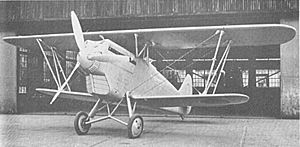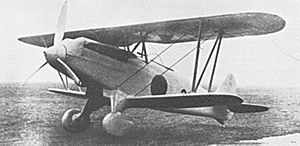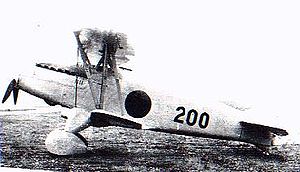Kawasaki Ki-10 Video - Picture

|
|
Kawasaki Ki-10

Picture - Ki-10 Model 1
Role: Biplane fighter
Manufacturer: Kawasaki Heavy Industries
Designed by: Takeo Doi
First flight: March 1935
Introduced: 1935
Retired: 1942
Primary user: IJA Air Force
Number built: 588
The Kawasaki Ki-10 (ä¹äºå¼æ¦éæ©, KyÅ«go-shiki sentÅki, Army Type 95 Fighter) was the last biplane fighter used by the Imperial Japanese Army, entering service in 1935. Built by Kawasaki KÅkÅ«ki KÅgyÅ KK for the Imperial Japanese Army, it saw combat service in Manchukuo and in north China during the early stages of the Second Sino-Japanese War. Its reporting name given by the Allies was "Perry".
Design and development

Picture - Kawasaki Ki-10-II KAI prototype
The Ki-10 was designed by Japanese aeronautical engineer Takeo Doi, who had succeeded Richard Vogt as chief designer for Kawasaki. The design was in response to a requirement issued by the Imperial Japanese Army for a new fighter, and was the winner of a competition against Nakajima's Ki-11. Although the low-wing monoplane offered by Nakajima was more advanced, the Army preferred the more maneuverable biplane offered by Kawasaki. In order to overcome the speed disadvantage the Kawasaki team used a metal three-blade propeller in the third prototype, while flush-head rivets were used in an attempt to reduce drag.
The Kawasaki design had sesquiplane (unequal-span) wings, braced by struts, and with upper-wing ailerons. The structure was of all-metal construction, which was then fabric-covered. Armament consisted of two 7.7 mm (.303 in) Type 89 machine guns, synchronized to fire through the propeller. The initial production version was powered by a liquid-cooled 633 kW (850 hp) Kawasaki Ha-9-IIa V engine.
Operations
The Ki-10 was deployed in Manchukuo (Manchuria) and in the initial campaigns of the Second Sino-Japanese War in northern China. It proved an excellent dogfighter against the Chinese air force, including those active at the Battle of Wuhan. However, by the time of the Nomonhan Incident (Battles of Khalkhin Gol) in 1939, against the forces of Soviet Russia, it was largely obsolete.
At the beginning of the Pacific War, the Ki-10 was retired to training and secondary missions, but later returned to front-line service, performing short-range patrol and reconnaissance missions in Japan proper and China in January-February, 1942.
Variants

Picture - Another picture of the Kawasaki Ki-10-II KAI prototype
data from Japanese Aircraft of the Pacific War
Ki-10 : Prototype for Imperial Japanese Army Air Force (4 built in early 1935).
Ki-10-I (Army Fighter Type 95-I): Initial production version (300 built December 1935 - October 1937)
Ki-10-II : Prototype of modified Mark I, increased in length (1 built May 1936)
Ki-10-II (Army Fighter Type 95-2): Improved production version (280 built June 1937 - December 1938)
Ki-10-I KAI : Prototype Ki-10-I with modifications to engine and radiator (1 built October 1936)
Ki-10-II KAI : Prototype - Aerodynamic modification of Ki-10-II, now designated Ki-10-I-KAI, with 634 kW (850 hp) Kawasaki Ha-9-IIb engine (2 built November 1937)
Total production: 588 units
Operators
Japan
Imperial Japanese Army Air Force
1st Rentai IJAAF
4th Rentai IJAAF
5th Rentai IJAAF
6th Rentai IJAAF
8th Rentai IJAAF
11th Rentai IJAAF
13th Rentai IJAAF
4th Sentai IJAAF
9th Sentai IJAAF
33rd Sentai IJAAF
59th Sentai IJAAF
64th Sentai IJAAF
77th Sentai IJAAF
Akeno Fighter Training School
Specifications (Ki-10-II)
Data from Japanese Aircraft of the Pacific War
General characteristics
Crew: one, pilot
Length: 7.2 m (23 ft 8 in)
Wingspan: 10.02 m (32 ft 10½ in)
Height: 3 m (9 ft 10â
in)
Wing area: 23 m² (247.569 sq ft)
Empty weight: 1,360 kg (2,998 lb)
Loaded weight: 1,740 kg (3,836 lb)
Powerplant: 1x Kawasaki Ha-9-IIa, 634 kW (850 hp)
Performance
Maximum speed: 400 km/h at 3000 m (248.5 mph at 9,845 ft)
Range: 1,100 km (684 mi)
Service ceiling: 11,500 m (37,730 ft)
Rate of climb: 1,000 m/min (3,280 ft/min)
Wing loading: 75.7 kg/m² (15.5 lb/sq ft)
Power/mass: 0.36 kW/kg (0.48 hp/kg; 0.22 hp/lb)
Armament
2x fixed, forward-firing 7.7 mm (.303 in) Type 89 machine guns
Comparable aircraft
Gloster Gauntlet
Hawker Fury
Heinkel He 51
Bibliography
Francillon, Ph.D., René J. (1979). Japanese Aircraft of the Pacific War. London: Putnam & Company Ltd.. ISBN 0-370-30251-6.
Green, William; Gordon Swanborough (1990). The Complete Book of Fighters. London: Greenwich Editions. ISBN 0-86288-220-6.
Mikesh, Robert C.; Shorzoe Abe (1990). Japanese Aircraft, 1910-1941. Annapolis, MD: Naval Institute Press. ISBN 1557505632.
Living Warbirds: The best warbirds DVD series.
Source: WikiPedia